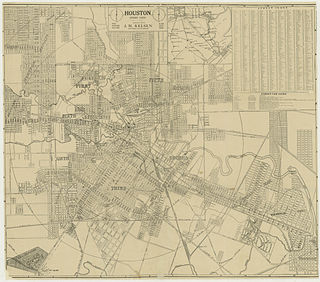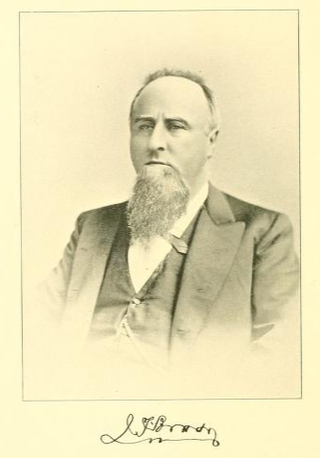
Nathan Fuller was a mayor of Houston and a businessman.

Nathan Fuller was a mayor of Houston and a businessman.
Nathan Fuller was a resident of Beaufort, North Carolina, where he was married to Charlotte M. Fuller. The family moved to Sumter County, Alabama around 1839. They moved to Houston around 1843. [1]
Fuller served two consecutive one-year terms as Mayor of Houston in 1853 and 1854. His principal initiative was the promotion of Houston as a terminal for a railroad. He promoted the Houston and Texas Central Railway to compete with the Buffalo Bayou, Brazos, and Colorado Railway, which located its eastern terminus in the rival town of Harrisburg, Texas. Meanwhile, Fuller also promoted the port of Houston by lobbying for a state grant for dredging and clearing obstacles from Buffalo Bayou. [2]

Pasadena is a city in the U.S. state of Texas, within the Houston–The Woodlands–Sugar Land metropolitan area. As of the 2020 U.S. census, the city's population was 151,950, making it the twentieth most populous city in the state of Texas, as well as the second-largest city in Harris County. The area was founded in 1893 by John H. Burnett of Galveston, who named the area after Pasadena, California, because of the perceived lush vegetation.

The city of Houston in the U.S. state of Texas was founded in 1837 after Augustus and John Allen had acquired land to establish a new town at the junction of Buffalo and White Oak bayous in 1836. Houston served as the temporary capital of the Republic of Texas. Meanwhile, the town developed as a regional transportation and commercial hub. Houston was part of an independent nation until 1846 when the United States formally annexed Texas. Railroad development began in the late 1850s but ceased during the American Civil War. Houston served the Confederacy as a regional military logistics center. The population increased during the war and blockade runners used the town as a center for their operations.
The Port of Houston is one of the world's largest ports and serves the metropolitan area of Houston, Texas. The port is a 50-mile-long complex of diversified public and private facilities located a few hours' sailing time from the Gulf of Mexico. Located in the fourth-largest city in the United States, it is the busiest port in the U.S. in terms of foreign tonnage and the busiest in the U.S. in terms of overall tonnage. Though originally the port's terminals were primarily within the Houston city limits, the port has expanded to such a degree that today it has facilities in multiple communities in the surrounding area. In particular the port's busiest terminal, the Barbours Cut Terminal, is located in Morgan's Point.
Harrisburg is a community that is now located within the city of Houston, Texas, United States.

Buffalo Bayou is a slow-moving body of water which flows through Houston in Harris County, Texas. Formed 18,000 years ago, it has its source in the prairie surrounding Katy, Fort Bend County, and flows approximately 53 miles (85 km) east through the Houston Ship Channel into Galveston Bay and the Gulf of Mexico. In addition to drainage water impounded and released by the Addicks and Barker reservoirs, the bayou is fed by natural springs, surface runoff, and several significant tributary bayous, including White Oak Bayou, Greens Bayou, and Brays Bayou. Additionally, Buffalo Bayou is considered a tidal river downstream of a point 440 yards (400 m) west of the Shepherd Drive bridge in west-central Houston.
The Allen Ranch, or Sam Allen Ranch, was one of the first and longest running ranches in the history of the state of Texas in the United States. The ranch was started a few years after the Texas Revolution in what is now southeast Houston and Pasadena. The ranch itself extended from Clear Lake to Harrisburg. The cattle range covered much of southeast Harris County and Galveston County covering many of the modern communities around Galveston Bay.

Glenwood Cemetery is located in Houston, Texas, United States. Developed in 1871, the first professionally designed cemetery in the city accepted its first burial in 1872. Its location at Washington Avenue overlooking Buffalo Bayou served as an entertainment attraction in the 1880s. The design was based on principles for garden cemeteries, breaking the pattern of the typical gridiron layouts of most Houston cemeteries. Many influential people lay to rest at Glenwood, making it the "River Oaks of the dead." As of 2018, Glenwood includes the annexed property of the adjacent Washington Cemetery, creating a total area of 84 acres (34 ha) with 18 acres (7.3 ha) still undeveloped.

The Houston Ship Channel, in Houston, Texas, is part of the Port of Houston, one of the busiest seaports in the world. The channel is the conduit for ocean-going vessels between Houston-area terminals and the Gulf of Mexico, and it serves an increasing volume of inland barge traffic.
The Buffalo Bayou, Brazos, and Colorado Railway, also called the Harrisburg Road or Harrisburg Railroad, was the first operating railroad in Texas. It completed its first segment of track between Harrisburg, Texas and Stafford's Point, Texas in 1853. The company established a western terminus at Alleyton, Texas prior to the Civil War. The railroad was sold after the war and reincorporated as the Galveston, Harrisburg, & San Antonio Railroad. This right of way was acquired by the Southern Pacific Railroad and is today a property of the Union Pacific Railroad.

When the city of Houston was founded in 1836 and incorporated in 1837, its founders—John Kirby Allen and Augustus Chapman Allen—divided it into political geographic districts called "wards". The ward system, a precursor to today's City Council districts, was a common political tool of the early 19th century, and is still used in some American cities. When the system was at its peak, the city had six wards, from the first to the sixth.

Houston, the most populous city in the Southern United States, is located along the upper Texas Gulf Coast, approximately 50 miles (80 km) northwest of the Gulf of Mexico at Galveston. The city, which is the ninth-largest in the United States by area, covers 601.7 square miles (1,558 km2), of which 579.4 square miles (1,501 km2), or 96.3%, is land and 22.3 square miles (58 km2), or 3.7%, is water.

Sidney Sherman was a Texian general and a key leader in the Texas Army during the Texas Revolution and afterwards.

For a period of over 7000 years, humans have inhabited the Galveston Bay Area in what is now the United States. Through their history the communities in the region have been influenced by the once competing sister cities of Houston and Galveston, but still have their own distinct history. Though never truly a single, unified community, the histories of the Bay Area communities have had many common threads.

William J. Hutchins was a businessman and a Mayor of Houston.

The McKee Street Bridge carries McKee Street across Buffalo Bayou in Houston, Texas. Built in 1932, the three-span reinforced concrete girder bridge connects the Second and Fifth Ward areas, northeast of downtown Houston. The bridge was listed on the National Register of Historic Places on September 3, 2002.
Thomas Howe Scanlan was a mayor of Houston, Texas. He supported the Union during Reconstruction, and was installed as an alderman and mayor during that period. As well as investing in real estate, he owned stakes in local companies, including rail transportation and utilities.

John Thomas Brady was an attorney, publisher, business promoter and politician. He served two terms in the Texas Legislature and one term in the Texas Senate.

Joseph Robert Morris was a metal worker, business owner, investor, and inventor. He briefly served as mayor of Houston, Texas.

The San Jacinto Street Bridge is a viaduct which crosses Buffalo Bayou in Houston, Texas. The structure is listed on the National Register of Historic Places (NRHP). This bridge was built in 1914 to replace an iron pivot bridge of 1883 origin, and rehabilitated in 1997. It is a transportation conduit connecting downtown and the historical Fifth Ward.
John Day Andrews was a tavern keeper, carpenter, merchant, planter, and politician. He worked in Virginia as a plantation overseer and owned a tavern. He relocated to Houston around 1838, where he worked as a carpenter, a dry goods merchant, and a planter. He served as an Alderman and a mayor of Houston.